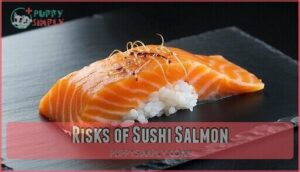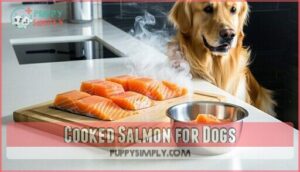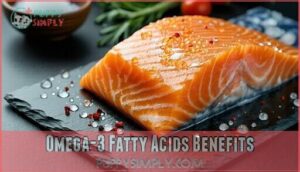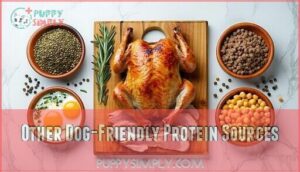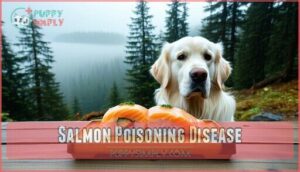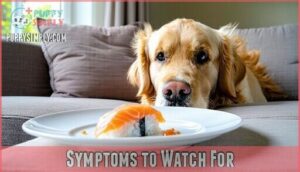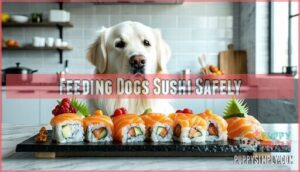This site is supported by our readers. We may earn a commission, at no cost to you, if you purchase through links.
 No, you shouldn’t feed your dog sushi salmon.
No, you shouldn’t feed your dog sushi salmon.
Raw fish can contain parasites and bacteria that cause salmon poisoning disease in dogs, which can be fatal if left untreated.
Your furry friend’s digestive system isn’t built to handle raw fish like ours can.
Even the sushi rice and seasonings might upset your pup’s stomach or contain harmful ingredients like garlic or onions.
If you want to share some fishy goodness with your dog, stick to plain, fully cooked salmon without seasoning.
Proper preparation makes all the difference between a dangerous meal and a healthy treat that provides those beneficial omega-3 fatty acids.
Table Of Contents
- Key Takeaways
- Risks of Sushi Salmon
- Can Dogs Eat Sushi Salmon
- Safe Alternatives to Sushi
- Dangers of Raw Fish Consumption
- Feeding Dogs Sushi Safely
- Frequently Asked Questions (FAQs)
- Can dogs eat sushi?
- Is fresh salmon safe to eat?
- Can dogs eat raw salmon?
- Can dogs eat sushi rice?
- Can dogs eat salmon skin?
- Is sushi salmon okay for dogs?
- Can my dog eat a piece of sushi?
- Is it safe to give my dog cooked salmon?
- Are there any health benefits to giving my dog salmon?
- How much salmon can I safely feed my dog?
- Conclusion
Key Takeaways
- You shouldn’t feed your dog sushi salmon as raw fish can contain parasites and bacteria that cause salmon poisoning disease, which can be fatal if left untreated.
- If you want to share salmon with your dog, stick to plain, fully cooked salmon without seasonings to provide beneficial omega-3 fatty acids safely.
- Watch for symptoms like vomiting, diarrhea, lethargy, and appetite changes if your dog accidentally eats raw fish, and contact your vet immediately.
- While dogs can eat plain sushi rice in small amounts, many sushi ingredients (wasabi, soy sauce, garlic) are toxic to dogs and should be avoided completely.
Risks of Sushi Salmon
Feeding your dog sushi salmon might seem harmless, but it comes with serious risks. Raw fish can carry harmful bacteria, parasites, and additives that could make your pup sick.
Bacteria and Parasites in Raw Fish
Raw fish risks for dogs include harmful bacteria like Salmonella and E.coli and parasites.
These can cause serious health issues.
Common parasite types include:
- Tapeworms, which affect digestion.
- Flukes, potentially causing organ damage.
- Roundworms, which may lead to severe illness.
Always avoid raw fish as the risks outweigh any nutritional benefits for your furry friend.
Harmful Additives in Sushi
Sushi might seem harmless, but not for dogs.
Ingredients like creamy avocado can upset digestion, while wasabi’s spiciness causes stomach discomfort.
Pickled ginger harbors preservatives, and deep-fried components carry Sauce Dangers from heavy sodium.
Even seemingly safe parts, like cream cheese, pack hidden dog health risks.
Always stay cautious with sushi ingredients; dogs deserve better choices.
Toxic Ingredients for Dogs
While sushi might look tempting, some ingredients can harm your dog.
Chocolate toxicity is well-known, but did you know onions and garlic can damage red blood cells.
Grapes might cause kidney failure, while xylitol effects can be life-threatening.
Avocado concerns are also real—it contains persin. So, if your dog sneaks sushi salmon, check for these toxic foods first.
Can Dogs Eat Sushi Salmon
Sure, your dog might give you those irresistible puppy eyes when you’re enjoying sushi salmon, but should dogs eat sushi? It’s not the best idea to share.
While sushi salmon may seem harmless, raw fish can carry bacteria and parasites that lead to serious health issues. Plus, sushi rolls often include ingredients unsafe for dogs.
Here’s what to keep in mind:
- Raw risk: Raw salmon for dogs can carry parasites, like tapeworms, and bacteria such as Salmonella.
- Hidden dangers: Wasabi, soy sauce, or creamy fillings aren’t dog safe sushi add-ons.
- Thiamine troubles: Sushi salmon contains thiaminase, reducing vitamin B1 needed by dogs.
- Veterinarian advice: Always consult your vet before introducing your dog to any "non-traditional" treats.
However, omega-3 fatty acids found in salmon skin can be beneficial.
Safe Alternatives to Sushi
If your dog’s begging eyes make it hard to say no to sushi, don’t worry—there are safer options they’ll love.
Cooked salmon and other dog-friendly proteins offer a healthy, risk-free alternative to raw fish.
Cooked Salmon for Dogs
Cooked salmon is a safe and nutritious choice for your dog when prepared correctly.
Opt for simple cooking methods like baking or boiling, skipping oils and spices. Always remove bones to avoid choking.
Portion sizes should suit your dog’s size since salmon benefits dogs as part of a balanced diet.
Plain, cooked salmon adds lean protein and supports dog nutrition.
Some owners are now offering their pets cooked salmon treats.
Omega-3 Fatty Acids Benefits
Omega-3 fatty acids in salmon work wonders for your dog’s coat health, making it shiny and soft.
They also support joint health, helping older dogs move easier, and boost brain function for sharper instincts.
Plus, they’re great for heart health and immune support. Dog nutrition salmon options, like cooked fish, can deliver these benefits safely—no need for sushi salmon risks!
Other Dog-Friendly Protein Sources
You’ve learned about healthy omega-3 benefits in dog-friendly salmon; now, explore other protein-rich options.
Dogs can enjoy:
- Cooked Chicken: Easy to digest and packed with protein.
- Lean Beef: Great for energy and muscle growth.
- Turkey Benefits: A low-fat, flavorful choice.
- Eggs Nutrition: A simple, nutrient-dense treat.
- Plant Proteins: Think lentils or chickpeas for variety.
For ideal canine health, consider essential amino acids from diverse sources.
Dangers of Raw Fish Consumption
Feeding your dog raw fish, including sushi salmon, can expose them to harmful bacteria and parasites.
While it might seem like a harmless treat, the risks far outweigh any potential benefits.
Salmon Poisoning Disease
Salmon poisoning is a dangerous gastrointestinal disease caused by Neorickettsia helminthoeca bacteria in raw salmon.
Dogs ingest parasitic flukes, starting the disease transmission. It’s common in the Pacific Northwest, making cooked fish a safer choice.
Preventing exposure is critical. Treating the condition involves antibiotics, dewormers, and supportive care. Know where fish originates—it might save your dog’s life.
| Aspect | Details |
|---|---|
| Bacteria | Neorickettsia helminthoeca |
| Transmission | Fluke lifecycle in raw salmon |
| Symptoms | Gastrointestinal distress, lethargy |
| Geography | Pacific Northwest regions |
| Treatment | Antibiotics and fluke removal medications |
Symptoms to Watch For
Raw fish can cause trouble for your dog, especially if something’s off with its preparation.
Common symptoms to watch for include digestive distress and appetite changes. You might notice your pup vomiting, experiencing diarrhea, or seeming unusually lethargic.
Allergic reactions, like skin irritation or itching, are also possible. In severe cases, neurological signs such as disorientation or tremors can appear, especially with salmon poisoning.
- Red flags: Vomiting, diarrhea
- Behavior changes: Lethargy, confusion
- Appetite signals: Reduced eating
- Neurological cues: Tremors or imbalance
- General distress: Unusual whining or restlessness
What to Do if Your Dog Ate Raw Fish
If your dog ate raw fish, keep a close eye on them. Raw fish, like sushi salmon, can cause serious health issues, including salmon poisoning.
Keep a watchful eye—raw fish can harm your dog, with risks like salmon poisoning demanding swift action for their safety.
Here’s what you can do:
- Vet consultation: Reach out to your veterinarian for advice immediately.
- Monitor symptoms: Watch for vomiting, diarrhea, or lethargy.
- Induce vomiting: Only do this if instructed by a professional.
- Activated charcoal: Ask your vet if this can help absorb toxins.
- Hydration support: Make certain they’re drinking enough water.
Quick action and veterinarian advice are key to keeping your pet safe. Raw fish bones, in particular, present choking and injury risks.
Feeding Dogs Sushi Safely
If you want to share sushi with your dog, you’ll need to be careful about how it’s prepared.
Stick to plain, cooked options and avoid risky ingredients like raw fish, wasabi, or soy sauce.
Plain Cooked Sushi Guidelines
If you’re letting your dog eat sushi, stick with plain , cooked salmon without any added seasonings.
Use safe ingredients like white or brown rice and avoid sticky varieties. Portion control matters—small bites guarantee balance without overfeeding.
Preparation methods should include thorough cooking to remove harmful bacteria. Consider sourcing quality ingredients for your dog’s sushi.
Always consult your vet before introducing sushi salmon or any new food to your dog’s diet.
Avoiding Toxic Ingredients
Stick to safe preparation when offering sushi salmon to your dog. Harmful sushi often includes dangerous seasonings like wasabi or risky additives such as soy sauce, which can upset their stomach or worse. Skip toxic alternatives and keep things simple.
- Avoid these ingredients: Wasabi, soy sauce, garlic.
- Focus on safe fish for dogs: Cooked salmon only.
- Check labels: Additive-free is best.
Monitoring for Adverse Reactions
After feeding sushi salmon, watch closely for digestive upset, allergic reactions, or behavioral changes.
Stool changes or appetite decreases may hint at sushi risks for dogs. If your dog eats raw salmon, prompt monitoring is vital.
Adverse reactions like vomiting or lethargy need a vet’s attention. Safety first—observing guarantees your pup enjoys treats without jeopardizing health!
It’s also important to watch for signs of high fat intake, which can lead to digestive issues.
Frequently Asked Questions (FAQs)
Can dogs eat sushi?
While you dream of sharing sushi with your furry friend, it’s not recommended.
Dogs shouldn’t eat raw fish due to harmful bacteria and parasites.
Stick to cooked salmon without seasonings for a safer option.
Is fresh salmon safe to eat?
Fresh salmon is safe when you cook it thoroughly to 145°F.
Raw consumption requires sushi-grade fish.
You’ll want to avoid undercooked salmon as it can contain harmful parasites and bacteria that cooking kills.
Can dogs eat raw salmon?
Picture a dog eyeing your salmon sashimi – don’t share it!
Raw salmon can contain deadly parasites causing "salmon poisoning disease" in dogs.
Always cook salmon thoroughly before giving small amounts to your furry friend.
Can dogs eat sushi rice?
Yes, dogs can eat plain sushi rice in small amounts.
It’s not harmful, but offers little nutritional value.
You shouldn’t make it a regular treat, and avoid rice with seasonings or vinegar.
Can dogs eat salmon skin?
Like a double-edged sword, salmon skin presents risks and benefits for your dog.
You can feed it when it’s fully cooked and all scales are removed.
Avoid raw skin due to parasite risks.
Is sushi salmon okay for dogs?
No, sushi salmon isn’t safe for dogs.
Raw fish can contain harmful bacteria and parasites that may cause illness.
It’s better to feed your dog properly cooked salmon without seasonings or additives instead.
Can my dog eat a piece of sushi?
It’s not recommended to give your dog sushi.
Most pieces contain ingredients that can be harmful to dogs, including raw fish with potential parasites.
Stick with plain cooked salmon as a safer alternative.
Is it safe to give my dog cooked salmon?
Cooked salmon is safe and healthy for your dog when prepared without seasonings.
It provides beneficial omega-3 fatty acids for their coat and skin.
Just make certain it’s well-cooked, boneless, and served in moderation.
Are there any health benefits to giving my dog salmon?
Yes, salmon offers excellent benefits for your dog’s health. It’s packed with omega-3 fatty acids that promote a shiny coat, reduce inflammation, support brain function, and boost their immune system.
How much salmon can I safely feed my dog?
While you’re keen to share salmon with your pup, limit it to a small, cooked portion.
This portion should be 1-2 tablespoons for small dogs, up to ¼ cup for larger breeds.
It should be given once or twice weekly as a treat.
Conclusion
When Jon’s Labrador stole sushi from the counter, it resulted in an emergency vet visit due to salmon poisoning disease.
Remember, dogs should never eat sushi salmon. While cooked salmon provides excellent omega-3 benefits for your pup, raw fish poses serious health risks.
Instead, treat your furry friend to properly prepared, plain cooked salmon without seasonings or oils. Your dog can still enjoy nutritious fish – just make the smart choice by leaving sushi for human consumption only, considering the risks of raw fish and the benefits of properly prepared meals.
- https://www.avma.org/resources-tools/avma-policies/raw-or-undercooked-animal-source-protein-cat-and-dog-diets
- https://pangovet.com/?utm_source=dogster&utm_medium=article&utm_campaign=dog-nutrition
- https://www.bostonveterinary.com/
- https://www.dogowner.co.uk/
- https://www.petmd.com/blogs/nutritionnuggets/jcoates/2013/dec/thiamine-deficiency-in-dogs-more-common-than-known-31123

